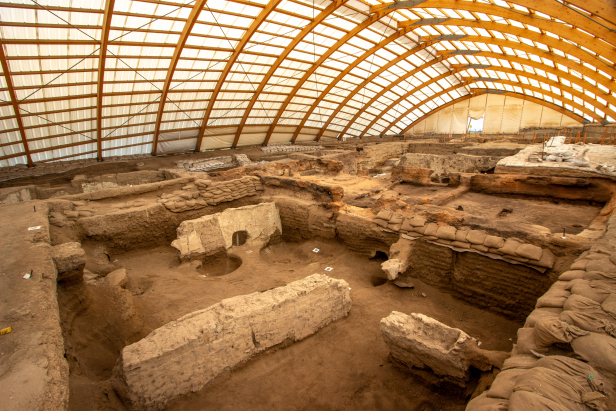Çatalhöyük Archeological Site
Çatalhöyük
/ By Josh
Cost: Free
The grounds are set up with a ticket system so presumably an entry fee was or will be charged in the future
Great for: Neolithic History, Lovers of Mud Bricks

Çatalhöyük is one of the oldest human settlements, one of the largest of its era, and has been one of the richest in regards to just how much archeologists have been able to learn about Neolithic peoples. 9000 years ago, up to 8000 people lived in this settlement of mud brick houses packed tightly together with no streets between them. Rather than streets people reached their homes by way of the roof tops and entered through holes in the roof via ladders. Çatalhöyük has given us some of the most famous mother-goddess statuettes in archeology, what is potentially the first map, the world’s oldest ceramic shaker, and the world’s oldest wall murals. In its time it was a place of new technologies, domestication of new species and metal works. Artifacts in Çatalhöyük have also shown that Neolithic peoples traded in goods over a wide area from around the Mediterranean basin and Red Sea.
Subscribe to The Art of Wayfaring

Why Visit?
At Çatalhöyük there are four main things to see. The first is the small museum holding what is a blend of artifacts as well as replicas of more important items found on the site that are now housed at more major museums such as the one in Istanbul and Ankara. This is also where you will get the most information regarding the history of the dig as well as explanations regarding how the town was structured, how people lived, politics, ritual, religion, etc. Interestingly, some of the interpretations given have more recently been rejected making Çatalhöyük a fascinating study in the evolution of in-vogue archeological theories being pushed upon limited evidence.

Next to the museum is a reconstruction of an original Çatalhöyük style house with explanations of the different aspects of the design and construction. This includes furs, wall paintings, and grave platforms, although you don’t get to enter through the roof like they did when Çatalhöyük was inhabited. If you keep a close eye out when driving through small towns near Çatalhöyük you may notice that this Neolithic construction isn’t altogether very different from what is still in use all over the region.
Up the hill are two large dig sites covered with permanent roofing to protect the fragile mud brick from the elements. These have been set up as displays with some signage and viewing platforms for visitors.

All in all there isn’t a ton to see here. Neolithic digs don’t tend to lend themselves to tourist attractions as they will often lack the size and diversity of the later periods. Due to the fragility of mud brick it also means that much greater measures must be taken to protect the remains; usually sandbags, tarps, or permanent roof structures. These are necessary steps needed to preserve the site but do make them less engaging for the visitor.

How To Get There
Rental Car
If you have a private car Çatalhöyük is quite close to Çumra (12 km) and Konya itself is only a one hour drive (41 km) to the southeast of the city center.
For more about car rental and driving in Turkey make sure to read our full drivers guide.
Bus
By public transit you could take a minibüs from Konya to Çumra then continue by taxi to the site or take the Karkın minibüs from Konya to Kük köy and walk the remaining kilometre.
Where To Stay
As Çatalhöyük is more or less in the middle of nowhere you will probably want to stay in either Çumra or Konya itself. Either one is fairly close, though Çumra doesn’t have much to offer tourists.
Other Tips
If you visit during the summer excavation season there is a good chance that there will be archeologists and other staff on site working which may add a great deal of other action to see depending on where the excavation and processing happens. If you or your kids are interested in studying archeology this may be a great opportunity to get a glimpse of the process.
Have any tips or info to add? Spot any mistakes? We’d love to hear about it.